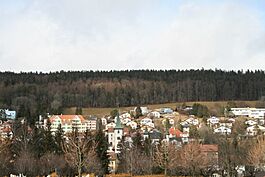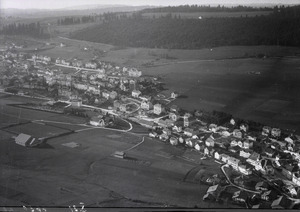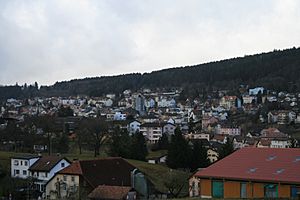Tramelan facts for kids
Quick facts for kids
Tramelan
|
||
|---|---|---|

Tramelan
|
||
|
||
| Country | Switzerland | |
| Canton | Bern | |
| District | Jura bernois | |
| Area | ||
| • Total | 24.83 km2 (9.59 sq mi) | |
| Elevation | 900 m (3,000 ft) | |
| Population
(Dec 2020 )
|
||
| • Total | 4,607 | |
| • Density | 185.54/km2 (480.55/sq mi) | |
| Postal code |
2720
|
|
| Surrounded by | Mont-Tramelan, Corgémont, Tavannes, Saicourt, Les Genevez, Montfaucon, Le Bémont, Saignelégier, La Chaux-des-Breuleux | |
Tramelan is a town in the canton of Bern in Switzerland. It is located in the French-speaking part of the Bernese Jura region. This area is known for its beautiful landscapes and rich history.
Contents
Tramelan Through Time
Tramelan was first mentioned in old records in 1179. Back then, it was called Trameleins. It also had a German name, Tremlingen, but this name is no longer used today.
During the Middle Ages, a church in Saint-Imier owned most of the land in Tramelan. The villages were part of the seigniory of Erguel. This area was ruled by the Prince-Bishop of Basel. From the 1200s to the mid-1400s, a local noble family governed Tramelan. They likely ruled under the Prince-Bishop.
The villages of Tramelan-le-Bas and Tramelan-le-Haut were first mentioned in 1334 and 1358. In 1481, 1543, and 1581, these two villages met to officially decide their shared border. In 1686, people from Neuchâtel moved here and started the village of Mont-Tramelan.
After France won a war in 1797, Tramelan became part of France. It was first in the Mont-Terrible area, then in Haut-Rhin. When Napoleon was defeated in 1815, Tramelan became part of the Canton of Bern in Switzerland.
The village church of Tramelan was once controlled by the Archbishop of Besançon. This made it a special area within the diocese of Basel. In 1530, the villages became Protestant and joined Basel. A fire destroyed the church in 1839. It was rebuilt in 1843-44 and later updated in 1958 and 2000. The Catholic Church of Saint-Michel was built in 1910.
In 1884, a narrow-gauge railway connected Tramelan to Tavannes. This railway was extended to Le Noirmont in 1913. In the early 1700s, the watchmaking industry began to grow in Tramelan. This slowly turned the villages into an industrial hub. By 1896, about 2,500 people worked in watchmaking, either in factories or from home.
The skills learned from making watches helped Tramelan develop other types of manufacturing in the 1900s. By 1958, there were 75 manufacturing companies with about 1,400 workers. However, in the 1970s, the demand for watches dropped. Many factories closed, and the population decreased. A large factory, bought by Longines in 1961, closed in 1983. But by the late 1990s, the watch industry recovered. Watch part factories and workshops reopened. In 2005, over 40% of the jobs in Tramelan were in manufacturing.
Where is Tramelan?
Tramelan covers an area of about 24.88 square kilometers (9.61 square miles). A large part of this land, about 58.5%, is used for farming. Forests cover 31.5% of the area. Buildings and roads make up 8.8% of the land. Only a small part, 1.2%, is unproductive land.
Most of the built-up area is for housing and other buildings (5.0%). Roads and other transport areas make up 2.7%. In the forested areas, 27.5% is dense forest, and 4.0% has orchards or small groups of trees. For farming, 6.8% is used for crops, 34.2% for pastures, and 17.3% for mountain pastures.
Tramelan is located in the Bernese Jura region. It was formed in 1952 when two smaller towns, Tramelan-Dessus and Tramelan-Dessous, joined together.
Tramelan's Coat of Arms
The blazon of Tramelan's coat of arms shows a red shield with a silver band going from top left to bottom right. On this band are three green linden leaves.
People of Tramelan
Tramelan has a population of about 4,374 people. About 11.4% of the people living here are foreign nationals. Over the last ten years (2000-2010), the population grew by 1.7%. Most of this growth came from people moving into the town.
Most people in Tramelan (about 86.3%) speak French as their main language. German is the second most common language (8.2%), followed by Italian (2.0%).
In 2008, about 49.8% of the population was male and 50.2% was female. Many people (about 52.8%) were born in Tramelan and still lived there in 2000. Others were born in the same canton (15.8%) or elsewhere in Switzerland (14.8%). About 13.2% of the population was born outside Switzerland.
Children and teenagers (0–19 years old) make up 21.8% of the population. Adults (20–64 years old) are 57.1%, and seniors (over 64 years old) are 21.1%.
In 2000, there were 1,560 single people in Tramelan. There were 2,041 married people, 367 widows or widowers, and 197 divorced people.
There were 698 households with only one person and 119 households with five or more people. Most apartments (86.2%) were lived in all the time. Some (7.7%) were used seasonally, and 6.2% were empty. In 2010, new homes were being built at a rate of 2.4 new units per 1000 residents. In 2011, about 3.58% of homes were empty.
The chart below shows how Tramelan's population has changed over time:

What to See in Tramelan
The small village area of Le Cernil / La Chaux de Tramelan is a special place. It is listed as part of the Inventory of Swiss Heritage Sites. This means it is an important historical and cultural area.
How Tramelan Makes a Living
Tramelan is home to the Armand Nicolet watch factory. It also has the Dimier factory, which makes important parts for watches like the Tourbillon and Hairspring.
In 2011, Tramelan had a low unemployment rate of 2.52%. In 2008, there were 2,039 people working in the town.
- About 115 people worked in farming and related businesses.
- 896 people worked in manufacturing, like making watches or other goods. There were 51 businesses in this area.
- 1,028 people worked in services, such as shops, transport, or healthcare. There were 132 businesses in this area.
In 2008, there were 1,783 full-time jobs. Most manufacturing jobs (87.7%) were in factories, and 11.4% were in construction. In the service sector, jobs included sales (19.7%), transport (13.1%), hotels and restaurants (7.0%), finance (2.7%), technical jobs (5.9%), education (26.3%), and healthcare (13.3%).
In 2000, 687 workers came into Tramelan for work, while 750 workers left to work elsewhere. This means more people leave Tramelan for work than come in. About 8.7% of workers coming into Tramelan are from outside Switzerland. About 8.6% of working people used public transport to get to work, and 58.3% used a private car.
Beliefs and Churches
Based on the 2000 census, about 47.3% of the people in Tramelan belonged to the Swiss Reformed Church. About 21.9% were Roman Catholic. A small number (0.86%) were Orthodox Christians, and 0.19% belonged to the Christian Catholic Church. About 34.57% belonged to other Christian churches.
There were also about 1.75% of the population who were Islamic. A very small number were Hindu or belonged to other churches. About 6.87% of the population did not belong to any church, or were agnostic or atheist. About 3.58% did not answer the question about their religion.
Learning in Tramelan
In Tramelan, about 38.5% of the population has finished upper secondary education. This is education after primary school. About 7.8% have gone on to higher education, like university or a specialized college.
The Canton of Bern has a school system that starts with one year of optional Kindergarten. Then, students go to six years of Primary school. After that, there are three years of mandatory lower Secondary school. In secondary school, students are grouped by their abilities. After lower secondary, students can continue their education or start an apprenticeship (learning a trade).
During the 2010-11 school year, 520 students attended classes in Tramelan. There were 5 kindergarten classes with 84 students. About 9.5% of these students were not Swiss citizens, and 19.0% spoke a different language at home than in the classroom. There were 15 primary classes with 296 students. About 15.9% of primary students were not Swiss citizens, and 20.3% had a different home language. In lower secondary, there were 9 classes with 140 students. About 11.4% were not Swiss citizens, and 12.9% had a different home language.
In 2000, 30 students came to Tramelan for school from other towns. At the same time, 91 students from Tramelan went to schools outside the town.
Tramelan has a public library called the Bibliothèque communale. In 2008, the library had many books and other media. It loaned out many items that year.
Famous People from Tramelan
Tramelan is the birthplace of several notable people:
- André Luy, a talented organist.
- Max Mathez, a test pilot.
- André Ramseyer, a sculptor who created art.
- Virgile Rossel, a statesman and poet.
- Willy Rossel, a chef.
See also
 In Spanish: Tramelan para niños
In Spanish: Tramelan para niños










